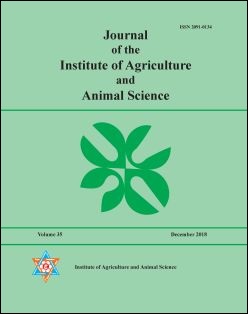Response of Cauliflower (Brassica oleraceae var. botrytis L.) to Different Levels of Boron under Maize Based Cropping System
DOI:
https://doi.org/10.3126/jiaas.v36i1.48425Keywords:
biomass, boron partitioning, curd yield, residual boron, uplandAbstract
To assess the effect of Boron (B) application on cauliflower, we conducted a greenhouse pot experiment that consisted of soil application of five levels of nutrient i) no input of fertilizers, ii) N:P2O5:K2O at the rate of 200, 28.6, and 80 kg ha-1 respectively (recommended dose of NPK),iii) recommended dose of NPK plus 1.1 kg ha-1 B, iv) recommended dose of NPK plus 2.2 kg ha-1 B, and v) recommended dose of NPK plus 4.4 kg ha-1 B. Total plant biomass was 106 gplant-1 at 4.4 kg B ha-1 compared to 79 g plant-1 at the control of no nutrient inputs. Relative to the control treatment, there was a two-fold increase in fresh curd yield at 1.1 Kg B ha-1 application. Boron application improved the shoot B content as well as its partitioning towards curd and was associated with higher B concentration in the curd. While the soil residual B was 0.26 mg Kg-1 when no B was applied, it was 0.3 mg Kg-1 at 4.4 Kg B ha-1 application. It is concluded that soil B application tends to improve the yield and quality of cauliflower cultivated at the upland maize based system in mid-hill areas of Nepal.

